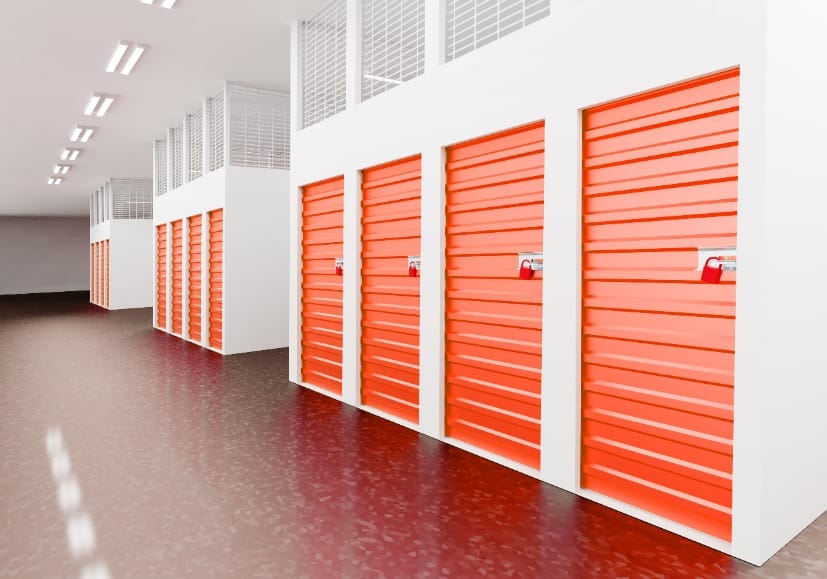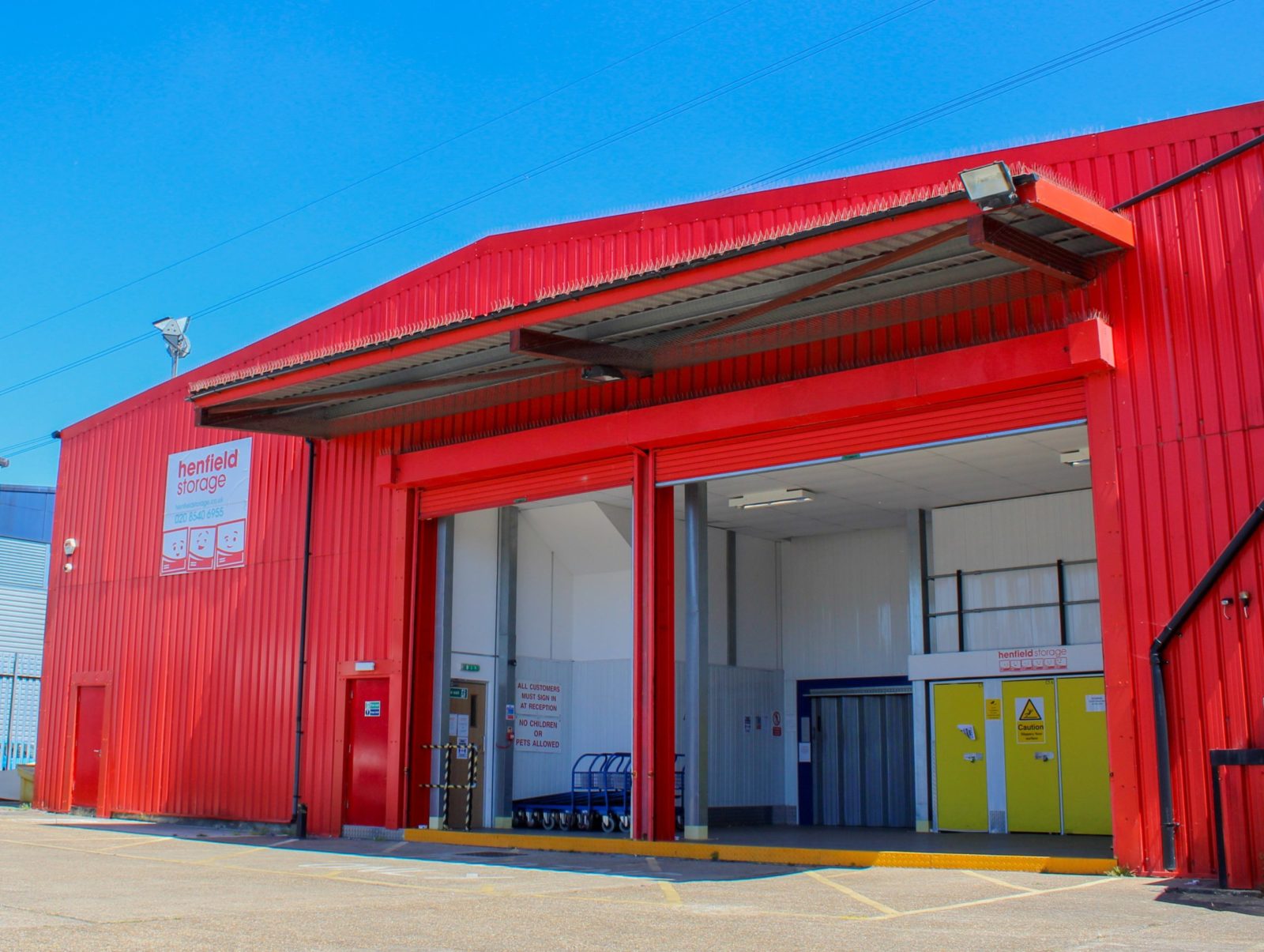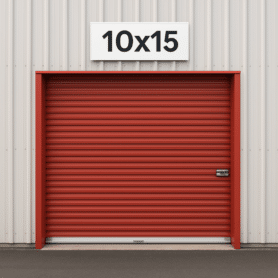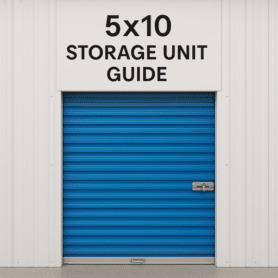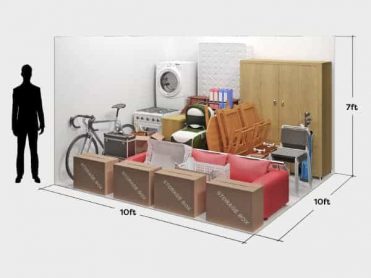More people in the UK are turning to self-storage than ever before. Usage has jumped from 1.29% in 2018 to 3% in 2024, with 9% of people considering storage to free up space at home. It’s clear that demand is only growing.
If you’re looking into renting a unit, you’re probably wondering about self storage prices and how to get the best deal. This guide breaks it all down, covering costs and the key factors that can affect what you’ll pay weekly and monthly.
Self Storage Prices (weekly & monthly)
Here’s a general breakdown of self storage prices in the UK, based on the Self Storage Association UK’s 2024 report. Costs vary depending on unit size and location, but this gives you a rough idea of what to expect:
| Unit Size | Estimated Weekly Cost (£) | Estimated Monthly Cost (£) |
|---|---|---|
| 25 sq ft | £20–£30 | £87–£130 |
| 50 sq ft | £30–£50 | £130–£217 |
| 75 sq ft | £40–£70 | £174–£304 |
| 100 sq ft | £50–£90 | £217–£390 |
| 150 sq ft | £70–£110 | £304–£477 |
| 200 sq ft | £90–£130 | £390–£564 |
Larger units tend to offer better value per square foot, thanks to economies of scale. However, choosing a unit should be based on actual storage needs rather than just cost per square foot. Renting more space than necessary, in most cases, won’t be worthwhile the long run.
Regional Self Storage Prices Comparison
Wondering if your specific location affects self storage prices? The answer is yes.
Here’s a breakdown of regional prices in the UK based on the same report:
| Region | Price Per Sq Ft (2023, Annual) |
| London | £38.80
(highest) |
| South East | £28.05 |
| East of England | £26.47 |
| Scotland | £23.87 |
| Yorkshire & Humber | £22.69 |
| South West | £21.17 |
| East Midlands | £20.82 |
| North | £20.34 |
| West Midlands & Wales | £20.34 |
| UK Average | £26.23 |
The most expensive regions for self storage are London (by a long shot) and South East, while cheaper options are available in the North and West Midlands. Meanwhile, Scotland and Yorkshire & Humber fall somewhere in between. Just remember that these prices are averages, so don’t be suprised to find slightly different rates in your area.
Henfield Storage Prices vs UK Averages (Weekly)
Below are Henfield’s weekly storage sq ft prices, which includes promo prices offering a 50% discount for the first two months. Let’s compare them to the UK average prices below:
| Unit Size & Pricing Type | Henfield Average Price | UK Average Price |
| 25 sq ft (Promo) | £8.99 | £20–£30 |
| 25 sq ft (Standard) | £17.98 | £20–£30 |
| 50 sq ft (Promo) | £15.00 | £30–£50 |
| 50 sq ft (Standard) | £30.00 | £30–£50 |
| 75 sq ft (Promo) | £18.38 | £40–£70 |
| 75 sq ft (Standard) | £36.77 | £40–£70 |
| 100 sq ft (Promo) | £24.23 | £50–£90 |
| 100 sq ft (Standard) | £48.46 | £50–£90 |
| 150 sq ft (Promo) | £32.35 | £60–£100 |
| 150 sq ft (Standard) | £64.70 | £60–£100 |
Even without our promo prices (like 50% off for the first two months), our rates are already lower than, or at least in line with, UK storage cost averages. And with the discount factored in, Henfield offers some of the best value for money in the country. It’s one of the many reasons our customers keep coming back!
What Drives Self Storage Prices?
Self-storage prices aren’t just about picking a unit and calling it a day. A handful of factors shape what you’ll pay—some obvious, others less so. Let’s break it down:
Demand: Location, Location, Location
Like housing, self-storage follows the law of supply and demand. In cities where space is tight—think London—prices climb because more people need storage, but there’s only so much room to go around. Meanwhile, in less crowded areas, you’ll likely find lower rates simply because there’s more space to spare.
Facility Amenities
Not all storage units are created equal. Some come with just four walls and a door, while others offer premium features that push the price up. Common extras include:
- Top-notch security – 24/7 surveillance, gated access, alarmed units
- Convenience services – Package handling, on-site moving help
- Facility perks – CCTV, bright lighting, free parking, forklifts
- Climate-controlled units – Essential for items sensitive to heat and humidity
Some facilities bundle these into their pricing, while others charge à la carte. Climate-controlled units, in particular, cost more since they require constant energy to keep conditions stable.
Insurance: Peace of Mind Comes at a Price
If you’re storing valuables, insurance is worth considering. Many storage companies, including Henfield Storage, offer coverage for theft, fire, or natural disasters. Naturally, the more valuable your items, the higher the insurance cost. But for peace of mind? It might be money well spent.
The Hidden Costs: Fees You Didn’t See Coming
Beyond the advertised rate, extra charges can sneak up on you. Be on the lookout for:
- Security deposits – Usually refundable if your unit is left in good condition
- Admin fees – One-time setup charge when you first rent
- Access fees – Some places charge for after-hours access
- Late fees – If you miss a payment, expect penalties
- Lock fees – If you don’t bring your own, you might have to buy or rent one
- Delivery or pickup fees – If you’re having items transported to or from the facility
- Packing materials – Boxes, tape, and bubble wrap often come at a premium
Before signing up, always ask about additional fees—otherwise, that “cheap” deal might not be so cheap after all.
How Long You Rent Matters
The longer you keep a unit, the more you’ll spend overall, but storage companies often sweeten the deal for long-term renters. Discounts for prepaid months or extended stays are common, so if you know you’ll need storage for a while, locking in a better rate upfront could save you money.
Size: Bigger Costs More, But It’s a Better Deal
Larger units naturally cost more, but they often give you more bang for your buck per square foot. While you’ll pay a higher total, the cost per square foot usually drops as unit size increases. If you’re debating between two sizes, do the maths—it might make sense to go bigger if the price difference is minimal.
How to choose the right storage unit size
Not sure which size storage unit is right for you? Don’t worry. We’ve broken down the most common storage unit sizes and what you can expect to fit in each one:
- 25 sq ft – About the size of a large walk-in closet or small spare room. Can hold bicycles, kayaks, small appliances, several boxes, and seasonal items, plus a few pieces of furniture.
- 50 sq ft – Comparable to a standard bedroom or large garden shed. Fits larger furniture items like sofas, refrigerators, and beds, along with multiple boxes and smaller household items.
- 75 sq ft – Slightly smaller than an average garage. Can store up to 120 medium boxes and is suitable for the contents of a small two-bedroom apartment.
- 100 sq ft – Roughly the size of your average garage. Ideal for storing the contents of a two-bedroom apartment or small house, including a couch, dining table, and multiple furniture pieces.
- 200 sq ft – About the size of a double garage. Can store the contents of a four to five-bedroom house, including large furniture, appliances, and several boxes.
What’s Included in Your Storage Unit?
At Henfield Storage, you’re not just getting four walls and a lock—you’re getting a hassle-free storage experience packed with perks. Here’s what’s included:
- 24/7 access – Drop by any time, day or night. Your storage is always available when you need it.
- Gated access & security – Secure entry, CCTV surveillance, and individual alarms keep your belongings safe.
- Flexible rental periods – Need storage for a few weeks or several months? Stay as long (or as short) as you like.
- On-site parking – Drive right up to load or unload with ease. Perfect for cars and vans.
- Free use of trolleys & pallet trucks – Moving in and out is a breeze with our equipment.
- Insurance options – Flexible coverage to protect your belongings against the unexpected.
- Friendly staff – Always on hand to assist with anything you need.
No time to drop off your stuff? Our Click+Store service lets you store your items without ever leaving home. We’ll pick them up, keep them safe, and even deliver them back to you with just two days’ notice. It’s a smarter, easier, and often more affordable alternative to traditional self-storage.
How to Save Money on Your Storage Costs

Self-storage costs can add up, but there are plenty of ways to keep expenses down. The easiest way? Store less. Many people overestimate how much space they need and end up paying for a larger unit than necessary. Here’s how to be more efficient with your storage and reduce costs.
Declutter Before You Store
Before renting a unit, take the time to go through your belongings. If you haven’t used something in years, do you really need to keep it? Selling, donating, or recycling unnecessary items helps free up space and means you won’t be paying to store things you don’t actually need.
Pack Smarter to Maximise Space
A well-packed unit can help you fit more into a smaller space, saving you money. Try these tips:
- Use boxes of the same size so they stack neatly and make the best use of space.
- Place heavier items at the bottom and lighter ones on top to make full use of the unit’s height.
- Leave a walkway so you can access items without having to move everything around.
Share a Unit
If you only have a few things to store or need short-term storage, consider sharing a unit with a friend or family member. Splitting the cost can make storage much more affordable.
Take Advantage of Discounts and Offers
Many storage companies offer promotions, such as the first month free or reduced rates for long-term rentals. It’s worth checking for deals before booking a unit, as they can make a big difference in cost.
Frequently Asked Questions
How Much does a storage unit cost per month?
Average monthly prices will depend on your facility’s region, unit size and additional features. On average, 25 sq ft units cost between £87–£130 per month, while 50 sq ft units range from £130–£217 per month. 100 sq ft units, meanwhile, will set you back around £217–£390 per month.
How much does a small storage unit cost per month?
Smaller units, ranging from 15 sq ft or 25 sq ft, will cost £50–£90 per month, and £87–£130 per month, respectively. These sizes are a great option for students and anyone inbetween property moves who need short-term storage.
What is the average self-storage cost per square foot in the UK?
According to the Self Storage Association (SSA) UK’s 2024 annual report, the average rental rate for self-storage units is £26.23 per square foot per year.
Is self-storage cheaper if I book long-term?
Yes, self-storage is generally cheaper if you book for longer periods. Many providers offer discounts to encourage longer stays, and post-pandemic, upfront deals like 50% off for multiple months have become common to maintain occupancy and reduce churn. Booking long-term can be a smart way to save.
At Henfield Storage, you can save even more with these long-term offers:
- 5% off + free collection when you prepay for 6 months
- 10% off + free collection when you prepay for 12 months
- 2 months half-price when you prepay for a minimum of 3 months
These discounts make long-term storage an affordable and cost-effective solution for your storage needs.
How do self-storage prices vary by region in the UK?
Self-storage costs vary by location, with London being the most expensive (£38.80 per sq ft) and the North and West Midlands & Wales the most affordable (£20.34 per sq ft). If you need a storage price benchmark for your specific area, you can use the UK average of £26.23 per sq ft.
Are storage prices expected to rise in 2025?
Yes, but with a caveat. While asking rents have increased, heavy discounting has kept overall returns from rising as much. Many operators offer 50% off for multiple months to attract new customers, as it’s becoming harder to convert first-time users.
The big question for 2025 is whether occupancy rates will bounce back or keep dropping. If demand picks up, operators will likely push prices higher. Oppositely, lower occupancy levels will mean that operators have to continue offering discounts to stay competitive.

